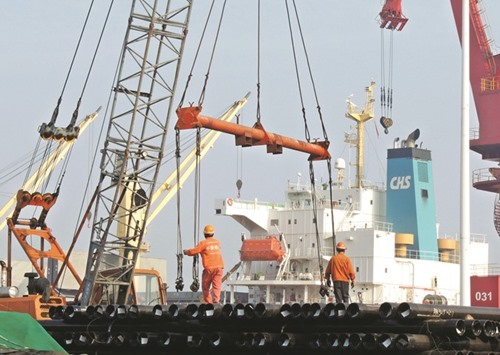China’s imports rose for the first time in nearly two years in August, figures showed yesterday, the 1.5% annual increase beating expectations in a positive sign for the world’s second-largest economy.
Exports dropped 2.8% on-year to $190.6bn, but the fall was smaller than the median forecast in a survey of economists by Bloomberg News.
China’s steel exports fell to the lowest in six months in August amid stronger domestic prices, offering relief to rivals overseas angered by a flood of cheap Chinese products.
But the global reprieve could be temporary as Chinese steel producers could easily boost exports to ship surplus output amid gradual efforts to address its chronic overcapacity.
The data from Customs was the latest indicator of improving health for the world’s biggest trader in goods, with the rise in imports – to $138.5bn – the first since October 2014.
China is crucial to the global economy and its performance affects partners from Australia to Zambia, which have been battered by its slowing growth.
Its economy expanded 6.9% last year, its weakest rate in a quarter of a century.
The trade figures’ “big surprise” was imports, said Julian Evans-Pritchard of Capital Economics, as they hinted at stronger domestic demand.
He noted that some of the improvement could be attributed to a recovery in commodity prices after years of declines.
Customs data also showed that import volumes of key commodities rose year-on-year, with iron ore climbing 18.3%, crude oil up 23.5%, and coal surging 52%.
“Climbing imports dispels the myth of weakening economy,” said analysts Jianguang Shen and Michael Luk of Mizuho Securities in a note.
Post-flood purchases after a summer of unusually heavy rains and widespread flooding in southern China also lifted imports, Zhao Yang of Nomura said in a note, pointing particularly to increased buying of automobiles to replace destroyed vehicles, and greater use of iron ore and oil owing to reconstruction work.
But such boosts will be short-lived as recovery efforts conclude, he said, adding that import growth was likely to be “more transient than long-lasting”.
In the fourth quarter “downward pressures posed by the possible slowdown of property investment” were likely to weigh down both imports and general growth momentum, he said.
For factors behind the exports performance, analysts pointed to a weaker exchange rate for the yuan, which has dropped roughly 5% in the past year despite pledges by central bankers not to depreciate the currency further.
The August trade surplus fell 13.6% from last year to $52bn.
But analysts with ANZ described the figure as “resilient” and said it would help alleviate net capital outflows – although they noted that sluggish global demand would still weigh on the outlook for China’s manufacturers.
China’s foreign exchange reserves at the end of August dropped to $3.19tn, according to central bank data, their lowest level since the end of 2011.
Coupled with the trade surplus, the reserves decline suggests that August saw “another month of steady hot money outflows”, the Mizuho analysts said, estimating that $36.1bn left the country in August.
The trade figures recovered from a worse-than-expected performance in July, when imports plunged 12.5% , weighed by weaker commodity prices and lacklustre domestic demand.
Earlier this month an official measure of manufacturing activity also beat expectations, rebounding to its strongest level in nearly two years, with the purchasing managers’ index (PMI) coming in at 50.4 in August, a sign of expanding activity in Chinese factories and mines.
But investors were tepid on the improved trade data, with Shanghai stocks closing only fractionally higher yesterday.

Chinese workers load steel pipes at a port in Lianyungang, Jiangsu province. China’s imports rose 1.5% year-on-year in August, figures showed yesterday.
